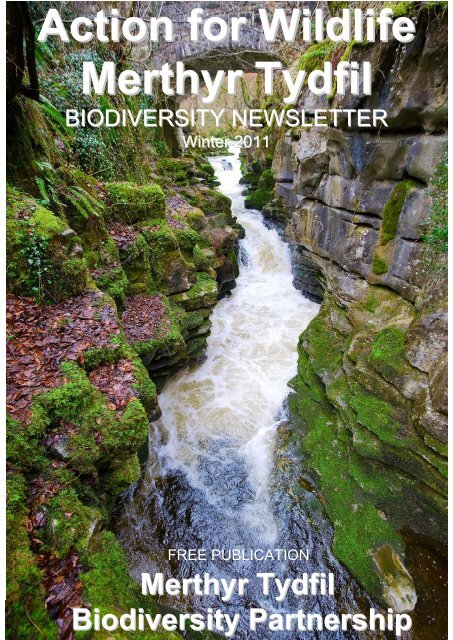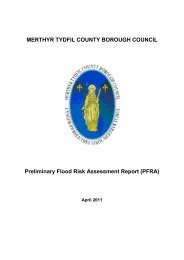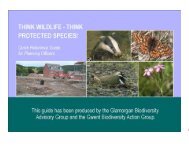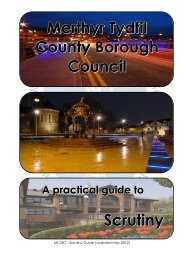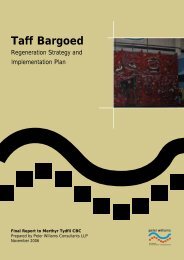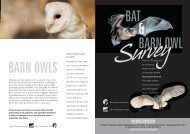Biodiversity Newsletter Winter 2011 - Merthyr Tydfil County Borough ...
Biodiversity Newsletter Winter 2011 - Merthyr Tydfil County Borough ...
Biodiversity Newsletter Winter 2011 - Merthyr Tydfil County Borough ...
Create successful ePaper yourself
Turn your PDF publications into a flip-book with our unique Google optimized e-Paper software.
Action for Wildlife<br />
<strong>Merthyr</strong> <strong>Tydfil</strong><br />
BIODIVERSITY NEWSLETTER<br />
<strong>Winter</strong> <strong>2011</strong><br />
FREE PUBLICATION<br />
<strong>Merthyr</strong> <strong>Tydfil</strong><br />
<strong>Biodiversity</strong> Partnership
Contents<br />
1 <strong>Biodiversity</strong>: Our Life Support System<br />
2-5 <strong>Biodiversity</strong> Good Practice –<br />
Examples of organisations and groups fulfilling<br />
their <strong>Biodiversity</strong> Duty<br />
6 British Trust for Ornithology Atlas<br />
<strong>Merthyr</strong> <strong>Tydfil</strong>’s Birds, by Daniel Jenkins-Jones<br />
7 Dramatic Return of the Otters<br />
Environment Agency Wales survey report<br />
8-9 Counting Crows<br />
Report on Gethin Raven Roost by Mark Evans<br />
10 <strong>Merthyr</strong>’s Recovering Rivers<br />
Report by Tony Rees, SEWRT<br />
11 Taking the Plunge<br />
Dipper Ringing Project – by Richard Facey<br />
12-16 Events & Other News<br />
An electronic version of this newsletter is available at:<br />
www.tinyurl.com/merthyrbiodiversity<br />
<strong>Merthyr</strong> <strong>Tydfil</strong> <strong>Biodiversity</strong> Partnership<br />
<strong>Merthyr</strong> <strong>Tydfil</strong> <strong>County</strong> <strong>Borough</strong> Council,<br />
Countryside Section,<br />
Room 223 Planning Department,<br />
Ty Keir Hardie,<br />
Riverside Court,<br />
Avenue De Clichy,<br />
<strong>Merthyr</strong> <strong>Tydfil</strong>,<br />
CF47 8XF<br />
Tel: 01685 726251<br />
Fax: 01685 375095<br />
Email: carys.solman@merthyr.gov.uk<br />
Front cover: Pontsarn Bridge and Taf Fechan gorge, by Jason Gotel
<strong>Biodiversity</strong><br />
Our life-support system<br />
<strong>Biodiversity</strong> is the variety of life on Earth. It is essential for<br />
sustaining the ecosystems that provide us with food, fuel,<br />
health, wealth, enjoyment, and other vital services.<br />
Your Role in Protecting <strong>Biodiversity</strong><br />
The vast majority of countries around the world have signed an<br />
agreement to preserve biodiversity, and in the UK all statutory<br />
bodies must, by law, have regard to biodiversity in the<br />
carrying out of their functions.<br />
(Natural Environment and Rural Communities Act, 2006)<br />
The ecosystems here in <strong>Merthyr</strong> <strong>Tydfil</strong> are of immediate<br />
importance and great value to us, and as members and<br />
significant beneficiaries of those systems, we have a duty<br />
of care towards them.<br />
<strong>Merthyr</strong> <strong>Tydfil</strong> <strong>Biodiversity</strong> Partnership<br />
is available to provide advice and support to individuals,<br />
groups and businesses. And the Local <strong>Biodiversity</strong><br />
Action Plan sets out the priorities for action.<br />
www.merthyr.gov.uk/Home/Local+Services/Planning/Nature+and+Wildlife/default.htm
BIODIVERSITY GOOD PRACTICE<br />
This section is devoted to highlighting how organisations,<br />
community groups and MTCBC departments have been<br />
considering biodiversity.<br />
Performing your <strong>Biodiversity</strong> Duty need not be expensive<br />
or difficult, and can provide a range of benefits such as<br />
financial savings, learning opportunities and publicity.<br />
Youth Inclusion Program Hedgelaying Course<br />
Project workers and young<br />
people from Catch 22, the<br />
local Youth Inclusion Program,<br />
attended a week-long<br />
hedgelaying course this winter.<br />
The course was delivered at<br />
Pen-y-Dre High School, who<br />
had a long section of hedge that<br />
they could not afford to maintain<br />
or lay. This is when the group<br />
of young volunteers stepped in,<br />
along with members of the local<br />
community, to spend the week<br />
laying the hedge and gaining an<br />
Agored Cymru qualification in<br />
the process.<br />
Weather that week was hard work, with gale force winds and driving rain on<br />
some days, but the boys managed to lay a section of hedge, get themselves<br />
some CV building qualifications, and do their school a favour at the same time.<br />
The course was delivered by Groundwork, & funded by MTCBC<br />
Foster Carer’s <strong>Newsletter</strong><br />
Social Services & Social Regeneration<br />
recently asked the <strong>Biodiversity</strong> Officer to<br />
make a contribution to their Foster Carer’s<br />
<strong>Newsletter</strong>.<br />
The quarterly publication goes out to all<br />
carer’s in the local authority, providing<br />
advice and resources.<br />
A ‘Nature Detectives’ activity sheet was<br />
produced and included in the latest<br />
newsletter, encouraging carers to get<br />
outdoors and explore the environment<br />
with their children.
BIODIVERSITY GOOD PRACTICE<br />
Partnership Working for an<br />
Eco-Garden at Troedyrhiw Junior School<br />
Troedyrhiw Junior School recently saw an area of wasteland on their<br />
grounds transformed into an Eco-garden and outdoor classroom,<br />
including planting beds, seating, a wetland area, and bug hotel.<br />
The project brought together the Tidy Towns Team and Probation<br />
Services, the Waste Awareness Officer, <strong>Biodiversity</strong> Officer, several<br />
local businesses, and many helping hands from the pupils.<br />
The involvement of Tidy Towns and the use of recycled materials<br />
wherever possible, for example from Bryn Compost Ltd, First Signs &<br />
Graphics Ltd, and <strong>Merthyr</strong> Tyres & Exhausts, meant that an estimated<br />
£10,000 was saved in the renovation of this area.<br />
Before<br />
Integrated Adult Services – Owl Box Project<br />
The council’s Learn Through the<br />
Outdoors team recently took on a<br />
tawny owl nesting box, donated<br />
by the Glamorgan Bird Club.<br />
The team spent a couple of<br />
sessions looking for a suitable<br />
location, which offered privacy,<br />
suitable trees and hunting ground,<br />
and eventually settled on<br />
Penmoelallt Woodland.<br />
They then had the difficult task of<br />
hoisting and attaching the very<br />
large and heavy structure several<br />
metres into a tree, and attaching<br />
it to the trunk.<br />
After<br />
The box will be monitored and maintained by the team, who are keen to<br />
aim some of their outdoor activities at tasks that will improve the local<br />
environment and people’s appreciation of it.
BIODIVERSITY GOOD PRACTICE<br />
Transitions Into Employment<br />
Environmental Projects<br />
The Social Services and Social<br />
Regeneration ‘Transitions into<br />
Employment’ project has been<br />
working with training providers<br />
Green Earth, to provide<br />
environmental training to young<br />
people in the <strong>Borough</strong>.<br />
This Communities First funded<br />
program has included activities such<br />
as hedgelaying and garden<br />
maintenance, all aiming to upskill<br />
young people, whilst also improving<br />
their environmental awareness and<br />
benefiting the local community.<br />
Fishing platform being<br />
constructed at the top pond<br />
Young trainees working on<br />
The garden at Ysgol y Graig<br />
Planting at Penywern Top Pond<br />
As part of the Penywern Project being carried<br />
out by <strong>Merthyr</strong> <strong>Tydfil</strong> Anglers Association,<br />
over 1000 native species plants were recently<br />
added to the top pond.<br />
This action was carried out in partnership with<br />
MTCBC Countryside department, and help<br />
with the task was provided by Groundwork<br />
volunteers. It is hoped that the plants will take<br />
hold and spread in the precious little soil<br />
available, providing a healthier and more<br />
attractive habitat for fish and other wildlife.<br />
Willow Weaving Training for School Staff<br />
A training day in the art of willow<br />
weaving was held in November, for<br />
local school teachers and grounds<br />
keepers. Around 13 staff attended the<br />
sessions, held at ICS and Troedyrhiw<br />
Junior School, in the hopes of learning<br />
the skills needed to make their school<br />
a greener and more interesting place<br />
for the pupils.<br />
Living willow structures such as<br />
tunnels, shelters, and sculptures not<br />
only benefit the children and improve the appearance of school grounds,<br />
but provide a habitat and benefit local biodiversity.
BIODIVERSITY GOOD PRACTICE<br />
Mural at Pentrebach Railway Station<br />
Last summer a wildlife photography walk<br />
was organised as part of the Connect 2<br />
Project, a partnership between Glamorgan<br />
Gates, MTCBC, and Sustrans. The project<br />
aimed to place artwork in a previously<br />
dilapidated area, as part of wider access<br />
Improvements to the Trevithick trail and<br />
Pentrebach railway station.<br />
The artwork depicts some of the local animal and plant life that can be<br />
found in the locality, and community involvement in the painting and<br />
gathering of photographs was a key part of the project<br />
There will be an official opening at the subway on the 15 th March, 11am.<br />
Purple Moorgrass at Gethin Woodland<br />
Forestry Commission Wales recently employed the British Trust for<br />
Conservation Volunteers (BTCV) to help manage an important habitat at<br />
Gethin Woodland. The area of purple moorgrass was being encroached<br />
upon by surrounding woodland and management was needed to prevent<br />
this rare habitat from shrinking and being lost. BTCV have now removed<br />
many of the birch trees which were growing on the grassland, and fresh<br />
regeneration in the area will be monitored by FCW.<br />
Purple moorgrass occurs<br />
on poorly drained acidic<br />
soils, and supports a<br />
diverse invertebrate<br />
fauna, as well as being<br />
important for amphibians<br />
and various birds and<br />
mammals, including UK<br />
priority species such as<br />
skylark, brown hare and<br />
otters.<br />
If you would like to carry out environmental projects,<br />
receive training, hold events, or have a project idea<br />
of your own and need support or advice, please get<br />
in touch!<br />
carys.solman@merthyr.gov.uk<br />
01685 726251
British Trust for Ornithology Atlas<br />
in <strong>Merthyr</strong> <strong>County</strong> <strong>Borough</strong> Council<br />
by Daniel Jenkins-Jones<br />
Waxwing, Hobby, Merlin and Lesser Spotted Woodpecker – just some of the<br />
excellent finds made in and around <strong>Merthyr</strong> recently as part of the British Trust for<br />
Ornithology’s National Atlas project. This important project, which draws to a close<br />
this year, has been mapping breeding and wintering birds all over Britain and Ireland<br />
since November 2007.<br />
One of the joys of taking part in the Atlas is that you find yourself in places you’ve<br />
never been to before. I found myself birding high up in the isolation of Gethin Woods<br />
and in the bustle of <strong>Merthyr</strong> Town Centre – and I was blown away by the beauty of<br />
the Cwm Taf Fechan Nature Reserve.<br />
I was lucky enough to find some special birds<br />
along the way too – Common Redstart,<br />
Wood Warbler, Spotted and Pied Flycatchers<br />
in woodland and Grey Wagtails, a displaying<br />
Dipper and Grey Heron on the river in the<br />
town centre. And recently, I had a count of<br />
16 Bullfinch in one survey area, a Woodcock,<br />
some Brambling and a huge flock of Siskin in<br />
Gellideg. Proof that it pays to go out and<br />
Waxwing Bombycilla garrulus<br />
about and do some birding around <strong>Merthyr</strong>.<br />
The winter recording period is now over but we could still do with some help from you<br />
during the breeding season (April>July). One of the most important things to do is to<br />
record ‘Confirmed Breeding’ for as many species as possible, and in <strong>Merthyr</strong> we still<br />
have a few gaps left to fill. Breeding can be confirmed in many ways: by recording an<br />
occupied nest; the presence of recently fledged young birds or an adult bird carrying<br />
food or a faecal sac.<br />
Have you seen any of the following species in and around <strong>Merthyr</strong> which fit into one<br />
of these categories<br />
Swift House Martin Spotted Flycatcher Barn Owl Kingfisher Jay<br />
If you have I’d love to hear from you. Please contact me on<br />
eastglamwebs@gmail.com<br />
or (07828) 093 613.<br />
Daniel Jenkins-Jones
Dramatic Return of the Otters<br />
to the Rivers and Wetlands of Wales<br />
Report from Environment Agency Wales<br />
In December 2010 Environment Agency Wales revealed the full findings of its latest<br />
otter survey –<br />
Nine out of every ten sites surveyed across Wales<br />
are now showing signs of otters,<br />
compared to only two out of ten in 1978.<br />
The ‘Otter Survey of Wales 2009-10’ reveals otters are now present at around 1000<br />
sites in Wales, as evidenced by the species’ distinctive droppings known as ‘spraints’,<br />
and their five toe footprints. The survey is the fifth of its kind designed to track the<br />
presence of otters (as opposed to their number), the last being in 2002.<br />
The Taff, Usk and Mid Glamorgan rivers all showed impressive improvement since<br />
the 2002 survey. In the River Taff there was a leap from 50 per cent of sites occupied<br />
by otters in 2002 to 78 per cent in 2010.<br />
In the River Taff and River Ely, otters can now be found in the middle of Cardiff. And<br />
they appear to be using many of the rivers of the valleys, despite humans living and<br />
working nearby.<br />
The Agency credits the otters’ return to a ban on pesticides, coupled with the<br />
introduction of legal protection for the otter and a dramatic improvement in<br />
water quality in Welsh rivers.<br />
Otters are a Priority Species in the UK<br />
and <strong>Merthyr</strong> <strong>Tydfil</strong> <strong>Biodiversity</strong> Action<br />
Plans, and are afforded special<br />
protection against disturbance under<br />
European Law.<br />
The results of the survey are now available from the Agency (to request a copy email /<br />
call Rob Strachan on rob.strachan@environment-agency.gov.uk / 01248 484076).<br />
Environment Agency Wales’ biodiversity<br />
officer Rob Strachan said: “The otter is an<br />
important biological indicator of the health<br />
of our rivers and wetlands.<br />
“our survey shows a major success story<br />
for pollution control, as well as investment<br />
by the water industry and efforts by<br />
landowners and river managers. We must<br />
continue to work together to ensure the<br />
otter remains the emblem of a healthy<br />
water environment.”<br />
Over 100 people helped deliver the ‘Otter<br />
Survey of 2009-10’ including staff from<br />
Environment Agency Wales, the Wildlife<br />
Trusts and officers working under various<br />
local authorities’ biodiversity action plans,<br />
as well as local mammal groups and<br />
naturalists.
Counting Crows<br />
A Study of Wales’ Second Largest Known Raven Roost<br />
by Mark Evans<br />
One morning, back in 2000, while walking, through the forestry to the West of<br />
<strong>Merthyr</strong>, I stopped to take stock of the bird species around me, when suddenly<br />
around fifty Ravens flew from one of the conifer blocks. Suspecting that these may<br />
have roosted there, I decided to return at dawn, to check and possibly count them. A<br />
few days later I did just that, though the count was secondary to the excitement and<br />
awe of watching these magnificent crows flying out in the pre dawn twilight. Since<br />
that time I have been counting them monthly, for my own satisfaction, though the<br />
records are also submitted to the local biodiversity records centre.<br />
The reason for the existence of the roost is Bryn Pica<br />
refuse tip, in RCT, at which most of them forage and<br />
the counts follow a broad pattern, but vary<br />
considerably, depending on weather conditions. The<br />
Ravens start flying from 30 to 45 minutes before dawn,<br />
so visibility, during the early stages of the count is<br />
usually extremely tricky. They often start calling around<br />
ten minutes before starting to fly out, then, when the<br />
time arrives, they leave in groups of various sizes. It<br />
can take anything up to an hour for them all to leave,<br />
during which the excitement of individual groups<br />
leaving the roost is usually punctuated by long periods<br />
of inactivity and silence.<br />
The roost seems to be more prone to low cloud and hill fog than most of the taller<br />
hills around it, which makes carrying out a successful count a bit hit or miss. Many is<br />
the morning I’ve travelled to the roost in the dark, only to find it clamped down with<br />
fog or cloud or had cloud descend while counting and had to give up and go home.<br />
So returning home after a successful count, the feeling is both of pleasure at the<br />
experience and relief at having completed it successfully.<br />
Over the years the patterns of behaviour have changed a little. The calling is<br />
fascinating to listen to, there being so many subtleties to the vocalisation. I’ve heard<br />
it said that the various calls can convey real meaning to other members of the roost<br />
and I can certainly believe that.<br />
What is the purpose of all those counts Are there any patterns or trends to be<br />
gleaned from the data This isn’t really my field, though a glance at the count totals<br />
for the past ten years reveals an annual pattern and a broad trend.<br />
Each year the numbers of birds using the roost are at their lowest in the winter<br />
months, increasing gradually in the spring and early summer, rapidly increasing in<br />
the later summer period, before dropping away less steeply in the autumn. The late<br />
summer peak is caused by breeding pairs and their young joining the roost, though<br />
why the numbers then drop again so rapidly is a bit of a mystery. Why a peak not a<br />
plateau
Average monthly population count<br />
(2000 - 2010)<br />
250<br />
200<br />
150<br />
100<br />
50<br />
0<br />
Jan Feb Mar Apr May Jun Jul Aug Sep Oct Nov Dec<br />
The trend in the number of birds using the roost over the ten years of the counts is<br />
generally a downward one, though whether this is a reflection of a similar downward<br />
trend in the local population of Ravens is unknown. I am aware that locally, the brood<br />
size of Ravens has decreased and this does seem to be reflected in my own<br />
observations of family groups in the late summer peak. Typically there will be two<br />
adults and one juvenile, whereas there would once have been two or three juveniles.<br />
I’ve always had a soft spot for Ravens. However the experience of counting them<br />
monthly for ten years has turned that into a love. Even having to get up at two thirty<br />
in the morning, in the summer months, to get to the roost in time, or sitting in sub<br />
zero conditions in the depths of winter cannot take away the thrill and sense of awe I<br />
feel every time I count ‘my Ravens’.<br />
Blaencanaid Raven Roost. Monthly Counts<br />
Jan Feb Mar Apr May Jun Jul Aug Sep Oct Nov Dec<br />
2000 N/A N/A N/A N/A N/A N/A N/A N/A N/A 274 265 215<br />
2001 119 218 No Access. Foot & Mouth Restrictions 146 89<br />
2002 126 132 142 166 325 333 379 310 312 147 105 56<br />
2003 108 102 128 158 199 208 175 199 57 38 51 44<br />
2004 20 72 81 184 192 N/A 179 173 N/A 88 16 23<br />
2005 54 42 62 121 117 170 175 N/A 201 137 105 129<br />
2006 50 N/A 67 74 52 114 203 149 130 143 60 100<br />
2007 58 42 90 74 92 170 N/A 163 158 104 79 46<br />
2008 72 86 84 50 59 139 185 278 368 163 N/A 38<br />
2009 32 79 65 102 97 N/A 88 344 103 162 72 76<br />
2010 N/A 119 87 199 219 188 152 261 196 177 157 50
A hundred years of industry saw the decline of the Taff, the last fifty<br />
have seen a dramatic recovery. Long may it continue!<br />
<strong>Merthyr</strong>’s Recovering Rivers<br />
by Tony Rees, South East Wales Rivers Trust<br />
The Environment Agency Wales has carried out and extensive<br />
programme of monitoring the run of Salmon on the Taff this winter.<br />
The figures show this winter has seen the largest runs of fish since<br />
the Barrage was closed and made into a Fresh Water lake.<br />
The number recorded was 430 salmon. It is possible that there were more than this<br />
entering the river as these are the ones that have been caught in the fish trap at<br />
Radyr weir.<br />
This information is valuable to the Agency and the South East Wales Rivers Trust as<br />
we are working together to improve passage for salmon and trout to help them get<br />
over these obstacles. The Trust looks for low cost solutions to do this work and it has<br />
plans for doing work on the weir at Effi Astex and the one on the Taff Fawr below<br />
Cefn viaduct. We hope to do this work in the summer of <strong>2011</strong><br />
The run of salmon in a river normally takes place on fairly high water, and although<br />
they will rest at the end of a shallow pool when running the river, they need a deep<br />
pool to become resident in when the flood decreases. Although fish have been seen<br />
trying to jump the weir at <strong>Merthyr</strong>, since the opening of the fish pass this does not<br />
seem to happen. The town weir pool however is not a suitable long term resting<br />
area, so any fish that do not find the pass and go through it will move back<br />
downriver.<br />
All this is far removed from the days when the Taff ran black down the valley due to<br />
the coal mines, and the anglers would not fish below <strong>Merthyr</strong> due to the pollution.<br />
Things that were once a common sight but seemed to disappear such as the Otter ,<br />
Kingfisher, Dipper, Heron are now making a real comeback and reports are coming<br />
in of otters, kingfishers and dippers being seen regularly along the Taff as far as<br />
Quakers Yard.<br />
The river has however lost, but not completely, an important member of the food<br />
chain: the minnow. This little fish used to be prominent in the upper reaches, but<br />
their numbers have dwindled. At one time there were large shoals of them, and<br />
many of the pools contained so many that it was jokingly said that you would walk on<br />
them if you were in the river. Why have their numbers diminished Could it be the<br />
river engineering works that have taken place over the years have destroyed their<br />
habitat or the very large floods such as those that washed the old bridge to<br />
Abercanaid away<br />
The river is also extremely clean now, as much investment has been put in to reduce<br />
the amount of sewerage that used to find its way into it. It could be that it is too<br />
clean, and the food the minnow used to rely upon is now not there to allow its<br />
numbers to expand again.
Taking the Plunge<br />
Dipper Monitoring Project<br />
By Richard Facey<br />
Dippers are a frequent and unmistakeable sight on the Taf Fechan. A brown dumpy<br />
bird, between the size of a robin and blackbird, with a big white bib which gives them<br />
their Welsh name, Bronwen-y-Dwr or White Breast of the Water. Often heard before<br />
they are seen, a dipper’s call is a loud high pitched “zit” given in quick succession.<br />
With its rapid water, variable pools and abundant boulders, Cwm Taf Fechan<br />
provides ideal habitat for the Dipper, which is one of Wales’ most intriguing and<br />
unique birds. What makes the Dipper so unique is that it is our only semi aquatic<br />
song bird! Dippers are able to swim under water, where they hunt for invertebrates<br />
such as caddis flies, without getting drenched. They even nest behind waterfalls,<br />
flying straight through the cascading water on their way to and from the nest.<br />
A new project, started recently, aims to monitor the population of Dippers breeding<br />
within the Cwm Taf Fechan Local Nature Reserve. Part of the project involves ringing<br />
the Dippers, which allows them to be measured and weighed, providing vital<br />
information about the birds. Ringing is undertaken by specially trained and licensed<br />
volunteers on behalf of the British Trust for Ornithology<br />
Two birds have already<br />
been ringed as part of the<br />
project. With a Dipper in the<br />
hand you can truly<br />
appreciate the attributes<br />
that make them so<br />
successful at the lives they<br />
lead. Their legs, which are<br />
extremely powerful, more<br />
like a bird five times their<br />
size, prevent them being<br />
washed away and allow<br />
them to walk under water in<br />
strong currents while they<br />
forage. Dipper’s also “fly”<br />
under water, so their wings<br />
are equally as strong as<br />
Richard holding the first dipper to be ringed as<br />
part of the project, on March 4 th at 7.30am<br />
their legs and their body<br />
shape highly streamlined<br />
like a fast boat.<br />
However, not everyone can get really up close and personal with a Dipper, but if you<br />
want good views of a Dipper look out for their favourite hunting spots along the river.<br />
These are easily found by looking out for rocks covered in white splashes – a dippers<br />
calling card! Sit quietly on the river back, just out of view, and you will soon be<br />
rewarded with a site of one of Wales’ most interesting birds.
Recent <strong>Biodiversity</strong> Partnership Events<br />
Wild Food & Bushcraft Walk<br />
Last October foragers gathered in Cwm<br />
Taf Fechan Local Nature Reserve, to<br />
spend the morning looking for wild food.<br />
The walk was lead by instructors from<br />
Dryad Bushcraft, who were able to show<br />
attendees what plants could be eaten,<br />
how to prepare<br />
them, how to locate underground water,<br />
make rope out of nettles, find a wild<br />
substitute for coffee, and much more<br />
Photo by Valleys Green, www.valleysgreen.co.uk<br />
Bird-Box Making Day<br />
On Sunday 5 th December there was a birdbox and<br />
feeder making day held at Cyfarthfa Park Wildlife<br />
Garden. This was a free event open to the<br />
community where people could come along and<br />
make a birdbox and feeder to take home for their<br />
garden.<br />
This event was aimed at making the gardens of<br />
<strong>Merthyr</strong> <strong>Tydfil</strong> more hospitable to local birds, and<br />
giving them a helping hand over winter.<br />
People of all ages attended, and over 20 birdboxes<br />
and feeders were made. Attendees were also given<br />
a bird-spotting sheet to help them identify the birds<br />
that might visit their gardens<br />
Planned <strong>Biodiversity</strong> Partnership Events<br />
Dawn Chorus Walk – Sunday 1 st May<br />
An early morning walk to celebrate International Dawn Chorus Day <strong>2011</strong><br />
Bat Detecting Evening – Friday 6 th May<br />
See back cover<br />
Wildlife Stand at Global Village Festival<br />
Sunday May 22nd<br />
If you would like to be kept informed about upcoming<br />
events like these, get in touch to be added to the mailing list
Wales <strong>Biodiversity</strong> Week <strong>2011</strong><br />
June 4 th – 12 th<br />
This years Wales <strong>Biodiversity</strong> Week will be happening in a few months, and there<br />
will be an opportunity to get involved with all sorts of events and activities in<br />
<strong>Merthyr</strong> <strong>Tydfil</strong> and around Wales.<br />
Wales <strong>Biodiversity</strong> Week is a great opportunity to give your<br />
own activities a biodiversity theme, for which you can<br />
receive extra support, publicity, and resources.<br />
Get in touch with the <strong>Biodiversity</strong> Officer if you would like to know about fun<br />
outdoor events happening for WBW in <strong>Merthyr</strong> <strong>Tydfil</strong>, or would like help with your<br />
own activities.<br />
A Living Wales<br />
A new framework for our environment,<br />
our countryside and our seas<br />
We all need to rethink the way we view, protect and manage the Welsh<br />
environment.<br />
Many people have become disconnected from their surroundings and<br />
underestimate the contribution that a healthy environment plays in their everyday<br />
lives. So it is not surprising that the environment doesn't feature strongly in many<br />
decisions we make about our future or our personal well being.<br />
With everyone's help, WAG want to change this. We want to make the health and<br />
quality of our natural environment a focus for everyone and a key part of decision<br />
making.<br />
We have published the consultation responses, our summaries of responses and<br />
our statement of next steps.<br />
These documents can be found at:<br />
http://wales.gov.uk/topics/environmentcountryside/consmanagement/nef/lang=en
Adult Learners Week Events<br />
<strong>Merthyr</strong> <strong>Tydfil</strong> 14 - 21 st May<br />
Introduction to Otters and Artificial Holts<br />
Training day provided by Keep Wales Tidy<br />
Wednesday 18 th May<br />
10am – 4pm<br />
How to survey for otters and make improvements to<br />
watercourse habitats, including artificial holt building.<br />
Due to the nature of the site and course content participants<br />
Must be fit and able-bodied<br />
Booking essential as places limited<br />
Contact paul.kent@keepwalestidy.org<br />
Woodland Wildlife<br />
<strong>Merthyr</strong> <strong>Tydfil</strong> <strong>Biodiversity</strong><br />
Partnership<br />
At the Global Village Festival<br />
Sunday 22 nd May<br />
Why the Bees<br />
Carmarthenshire Beekeeping Association<br />
At <strong>Merthyr</strong> Central Library<br />
Wednesday 18 th May<br />
10am – 12pm<br />
A stand with activities,<br />
information and live animals, to<br />
celebrate the International Day<br />
for <strong>Biodiversity</strong><br />
An educational talk about bees and their<br />
importance in our ecosystem.<br />
No booking necessary<br />
For further info: 01685 723057<br />
The Language of Flowers<br />
A Victorian Evening<br />
with historian Sally Pointer<br />
at Cyfarthfa Castle Museum<br />
Tuesday 17 th May<br />
6.30 – 8.30pm<br />
A talk and workshop exploring the language of flowers and their<br />
myths, stories and medical applications<br />
Booking essential as places limited<br />
01685 723112 or by e-mail museum@merthyr.gov.uk
<strong>Merthyr</strong> <strong>Tydfil</strong> & District Naturalists Society<br />
Events Program <strong>2011</strong><br />
21st march Charcoal Making training at Penmoelallt ( £10)<br />
First week April Hedge planting at Cilsanws<br />
12th April litter pick at Webbers pond<br />
14th May Nest box making at Penmoelallt 10-2 ( £5)<br />
2nd June official opening of Penmoelallt<br />
15th June bat moth evening ( 7pm setting moth trap) 1<br />
16th breakfast at Penmoelallt to study moths and make bug hotels<br />
12th July litter pick Webbers pond<br />
13th Aug BBQ and walk at Penmoelallt 10 am start<br />
10th Dec Reindeer making day Penmoelallt ( £5)<br />
Places can be booked by phoning Gareth & Val Evans 01685 722391
<strong>Newsletter</strong><br />
Thanks to those of you who contributed a story to this newsletter.<br />
For future editions I would appreciate further local interest stories and articles from<br />
individuals or groups. This could be a report or advert for an event, a story about<br />
wildlife you have recently spotted, or simply a chance to promote a local beauty spot.<br />
Send suggestions and contributions to carys.solman@merthyr.gov.uk<br />
<strong>Biodiversity</strong> Links<br />
www.biodiversitywales.org.uk — Wales <strong>Biodiversity</strong> Partnership<br />
www.ukbap.org.uk – UK <strong>Biodiversity</strong> Action Plan<br />
www.ccw.gov.uk — Countryside Council for Wales<br />
www.sewbrec.org.uk — Local Biolodiversity Records Centre<br />
www.naturcymru.org.uk — Nature of Wales Magazine<br />
www.nerc.ac.uk — Natural Environment Research Council<br />
www.jncc.gov.uk — Joint Nature Conservation Committee
Bat Detecting<br />
Evening<br />
Friday 6th May – 7pm<br />
Cefn Coed Community Centre<br />
Meet live rescued bats<br />
The evening will begin with a<br />
presentation and an opportunity<br />
to meet live rescued bats, there<br />
will then be a guided outdoor bat<br />
walk.<br />
You will be provided with a ‘Bat<br />
detector’ and helped to identify<br />
the species you find.<br />
All kindly provided by experts<br />
from the Valleys Bat Group.<br />
Search for wild bats using<br />
a bat detector<br />
FREE EVENT suitable for all ages<br />
No need to book. Further info: 01685 726251 or carys.solman@merthyr.gov.uk


